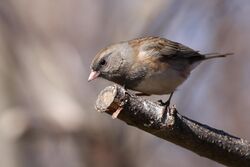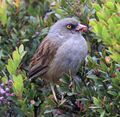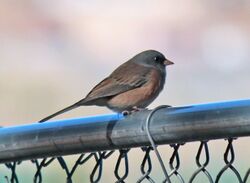Junco
Topic: Biology
 From HandWiki - Reading time: 3 min
From HandWiki - Reading time: 3 min
| Juncos | |
|---|---|

| |
| Slate-colored dark-eyed junco (Junco hyemalis hyemalis) female, Cap Tourmente National Wildlife Area, Quebec, Canada | |
| Scientific classification | |
| Domain: | Eukaryota |
| Kingdom: | Animalia |
| Phylum: | Chordata |
| Class: | Aves |
| Order: | Passeriformes |
| Family: | Passerellidae |
| Genus: | Junco Wagler, 1831 |
| Type species | |
| Junco phaeonotus (yellow-eyed junco) Wagler, 1831
| |
| Species | |
|
Junco hyemalis | |
A junco (/ˈdʒʌŋkoʊ/), genus Junco, is a small North American bird in the New World sparrow family Passerellidae. Junco systematics are still confusing after decades of research, with various authors accepting between three and twelve species. Despite having a name that appears to derive from the Spanish term for the plant genus Juncus (rushes), these birds are seldom found among rush plants, which prefer wet ground, while juncos prefer dry soil.
Their breeding habitat is coniferous or mixed forest areas throughout North America, ranging from subarctic taiga to high-altitude mountain forests in Mexico and Central America south to Panama. Northern birds usually migrate farther south; southern populations are permanent residents or altitudinal migrants, moving only a short distance downslope to avoid severe winter weather in the mountains.
These birds forage on the ground. In winter, they often forage in flocks. They eat mainly insects and seeds. They usually nest in a well-hidden location on the ground or low in a shrub or tree.
Taxonomy
The genus Junco was introduced in 1831 by the German naturalist Johann Georg Wagler for a single species, the yellow-eyed junco.[1] The yellow-eyed junco is therefore now the type species.[2] The genus name is from Latin iuncus meaning "rush".[3]
The genus contains five species:[4]
| Image | Common name | Scientific name | Subspecies | Distribution |
|---|---|---|---|---|
 |
dark-eyed junco | Junco hyemalis |
|
much of temperate North America |
 |
Guadalupe junco | Junco insularis | once the entirety of Guadalupe Island, now restricted to the northern part | |
 |
yellow-eyed junco | Junco phaeonotus |
|
from the southwestern United States south to Mexico and western Guatemala |
 |
Baird's junco | Junco bairdi | the Sierra de la Laguna of the southern Baja California peninsula in Baja California Sur, Mexico | |
 |
volcano junco | Junco vulcani | Costa Rica and western Panama |
References
- ↑ Wagler, Johann Georg (1831). "Einige Mittheilungen über Thiere Mexicos" (in German, Latin). Isis von Oken: Col 510–535 [526]. https://www.biodiversitylibrary.org/page/27512950.
- ↑ Paynter, Raymond A. Jr, ed (1970). Check-List of Birds of the World. 13. Cambridge, Massachusetts: Museum of Comparative Zoology. p. 62. https://www.biodiversitylibrary.org/page/14483297.
- ↑ Jobling, James A. (2010). The Helm Dictionary of Scientific Bird Names. London: Christopher Helm. p. 212. ISBN 978-1-4081-2501-4. https://archive.org/stream/Helm_Dictionary_of_Scientific_Bird_Names_by_James_A._Jobling#page/n212/mode/1up.
- ↑ Gill, Frank; Donsker, David; Rasmussen, Pamela, eds (January 2022). "New World Sparrows, Bush Tanagers". IOC World Bird List Version 12.1. International Ornithologists' Union. https://www.worldbirdnames.org/bow/sparrows/.
External links
Wikidata ☰ Q857319 entry
 |
 KSF
KSF
